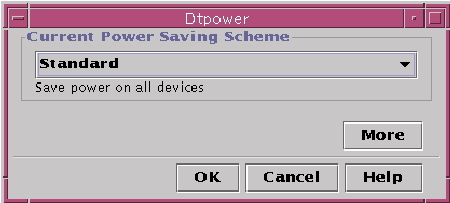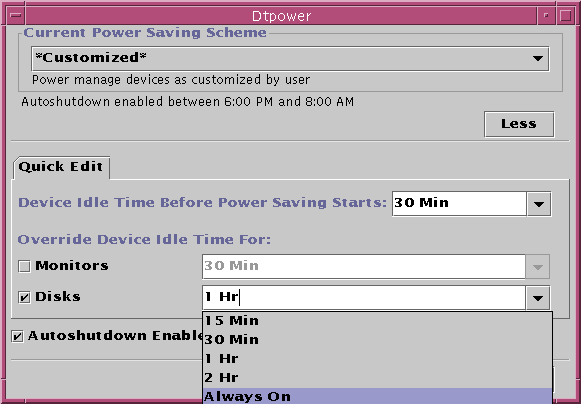Customizing Power Schemes
This chapter explains how you can create a customized power scheme, overriding the schemes that come preset in the Dtpower software.
You cannot overwrite the schemes that the system provides, but you can create a customized scheme. When you change a system-shipped scheme, a new scheme called “Customized” is created. When you edit another scheme, the first Customized scheme is overwritten by the new one. Thus, you can only save one customized scheme at any time.
The Customized scheme remains the default scheme even if you reboot your system. The Customized scheme only remains in the system until you select one of the three preset schemes. When you select a preset scheme, the Customized scheme is deleted and removed from the pull-down list of available schemes.
Power Management of Overall System
The system idle time defines the length of time for which the CPU and the devices connected to your system must be idle before they power down. Although you can use the GUI to assign only one idle time for all devices and the CPU, the idle time of each device is measured separately. If a system has two external hard drives, for example, and you are only using one of them, the other drive switches to power-saving mode after 30 minutes of idleness. The first drive switches to the power-saving mode separately, after an idle time of 30 minutes.
For information on configuring a different idle time for each device, refer to the power.conf(4) man page.
To Change System Power Management
-
Start Dtpower.
This launches the Dtpower basic window:
Figure 23–4 The Dtpower Basic Window

-
In the Dtpower basic window, select More.
The Quick Edit tab is displayed.
Figure 23–5 Quick Edit Tab

-
From the pull-down list for Default System Idle Time, choose the amount of time you want all the devices to be idle before powering down.
You can also type in the system idle time.
Power Management of Monitors
You can override the power management for the monitor from the overall system power management through the Dtpower GUI. When you change the idle time for monitor power, only the idle time for the monitor power changes. The idle time for all other devices and the system remains as specified in the Default System Idle Time box.
When the screen goes blank, some monitors can power down, and then power up when you use the computer again. Other monitors only blank the screen but do not power down.
Power management of workstations that have two monitors is also handled through Dtpower. In such a case, both monitors receive the same idle time setting.
Note –
In some earlier versions of the Solaris operating environment, power management for monitors was handled through the screensaver options of your windowing system, rather than through the Dtpower program. That is no longer the case. Power management for the monitor, disk drive, and system power are now all handled uniformly through the Dtpower program.
To Change Monitor Power Management
-
Start Dtpower.
This launches the Dtpower basic window.
-
In the Dtpower basic window, select More.
The Quick Edit tab is displayed.
-
Check the Monitors - Sleep After Idling For button.
The pull-down list for the idle time of the monitors becomes active.
Figure 23–6 Pull-Down List for Disks Idle Time

-
Either choose a time from the pull-down list of idle times or type a unique value in the edit box.
You must leave a blank space between the number you type and the units. Abbreviate the units to Sec, Min, or Hr, as appropriate. Decimal values are accepted. For example, if you enter 1.5 Hr, the display idle time is set to 90 minutes.
If you type a new value, the value is added to the list and is available the next time you use the pull-down list. The value is displayed in the format that you use in the edit box.
-
Click OK.
To Reactivate the Monitor
This restores the power to the monitor, but you may find that your screen is locked. The screen lock option is set through the Style Manager in CDE. Unlike in previous versions of the Power Management software, the screen lock is now completely independent of the Power Management software. If your screen is locked, enter your password to return to the desktop.
Power Management of Disk Drives
You can override the power management of disk drives just as you can for monitors. When you change the idle time for disk drives, only the power management settings for the disks changes. All disk drives connected to the system receive the same idle time. The idle time for all other devices and the system remains as specified in the Default System Idle Time box, see Figure 23–3.
For information on setting a different idle time for each disk drive, refer to the power.conf(4) man page.
To Change Disk Drive Power Management
-
Start Dtpower.
This launches the Dtpower basic window.
-
In the Dtpower basic window, select More.
The Quick Edit tab is displayed.
-
Check the Disk Drives - Sleep After Idling For button.
The corresponding pull-down list for idle time becomes active.
-
Either choose a time from the pull-down list of idle times or enter a unique value in the edit box.
Leave a blank space between the number you enter and units. Abbreviate the units to Sec, Min, or Hr, as appropriate. Decimal values are accepted. For example, if you enter 1.5 Hr, the disk drive idle time is set to 90 minutes.
If you enter a new value, the value is added to the list, and is available the next time you use the pull-down list. The value is displayed in the format you use in the edit box.
-
Click OK.
- © 2010, Oracle Corporation and/or its affiliates
